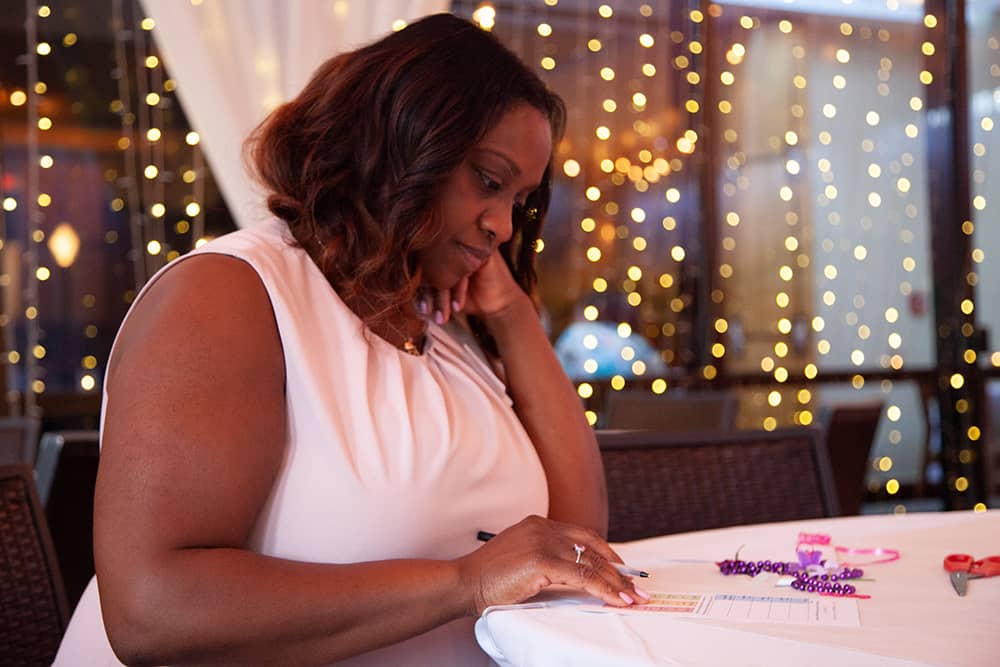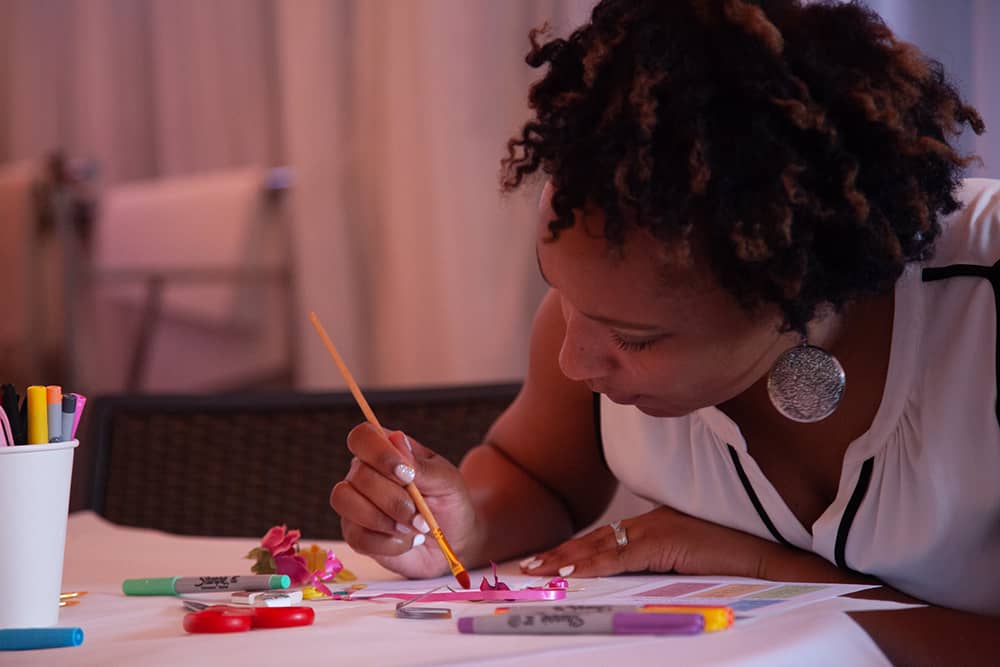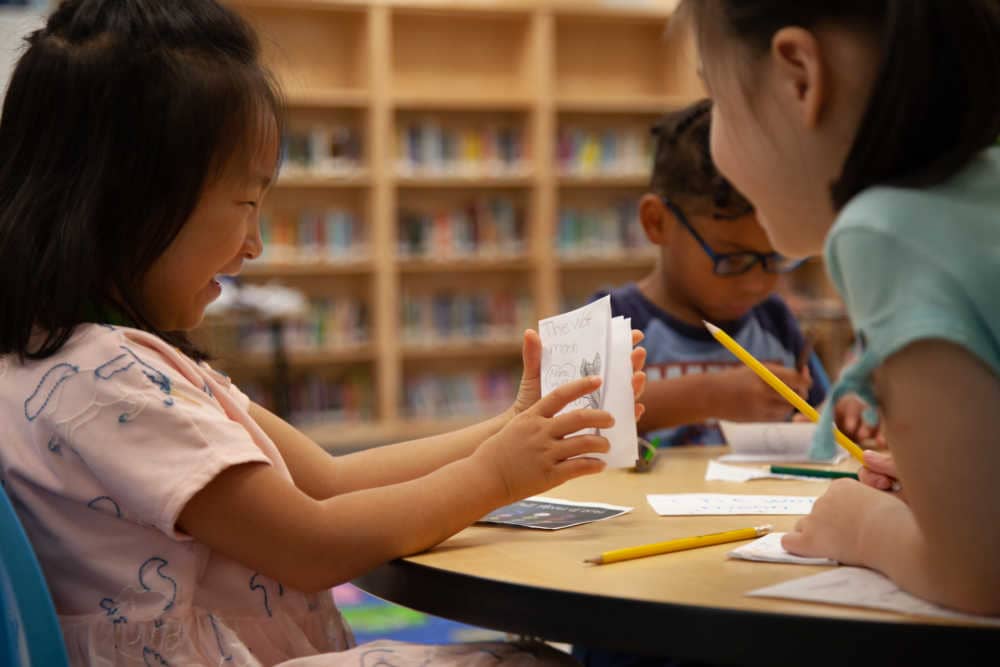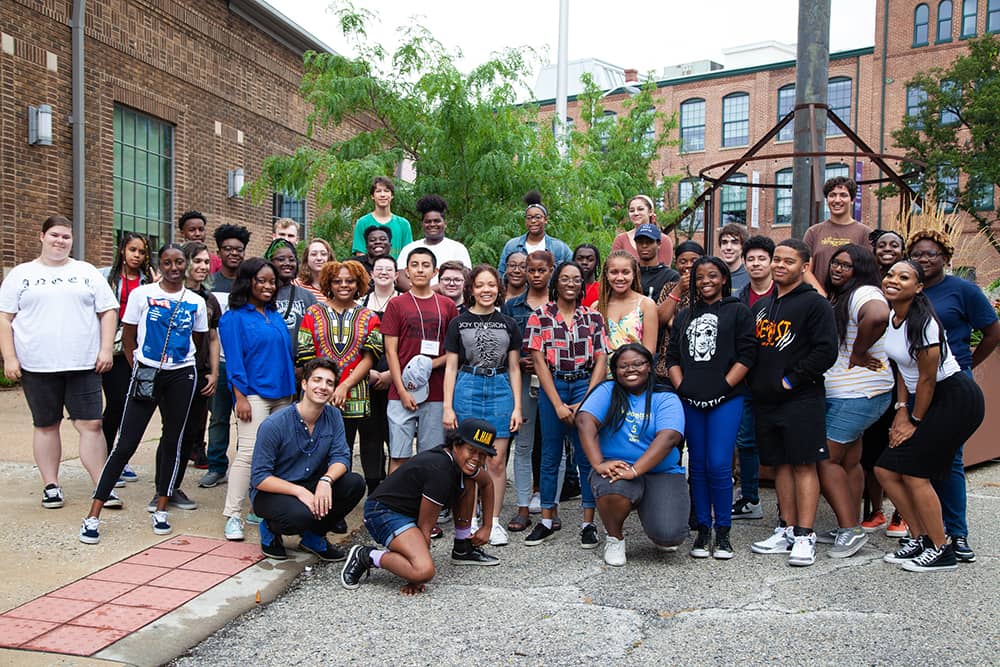Blog
Meet the Principal: Aleesha Manning
Mrs. Aleesha Manning, Principal of Cecil Elementary, began her teaching career in Baltimore City in 2003 as a Kindergarten teacher at Lakewood Elementary. The following year, she joined the Cecil family/community and served as a teacher and assistant principal. She is a graduate of Lincoln University in Pennsylvania with a degree in Early Childhood Education and earned her Master’s Degree in Instructional Leadership from Towson University. “Arts Integration has always been an important part of my teaching philosophy. As a teacher, and now as a principal, I am always seeking out ways for my students to participate in the arts,” she said. “We have applied for grants, created in-house programs, and work tirelessly to keep arts in our academic programming.”
“I have a teacher who has had experience with arts integration and she has explained that student outcomes are much higher,” Mrs. Manning said. “I want my students to be able to take their learning to the next level and experience academics in a new way that is highly effective and long-lasting.”
Knowing the value arts education and arts integration brings to her school and students’ education, Mrs. Manning applied for Young Audiences’ Principal Fellowship Program. The 11-session program began this summer and brought together ten outstanding Baltimore City Public Schools Principals, including Mrs. Manning, who are all committed to using the arts to build a positive school climate that advances student wholeness and/or to improve academic instruction.
Through the fellowship, she hopes to inspire teachers school-wide to intentionally integrate the arts into their lessons—even when an artist is not present in the classroom. “I have a teacher who has had experience with arts integration and she has explained that student outcomes are much higher,” Mrs. Manning said. “I want my students to be able to take their learning to the next level and experience academics in a new way that is highly effective and long-lasting.”
Mrs. Aleesha Manning, Principal of Cecil Elementary, is one of ten Baltimore City Public Schools principals selected to participate in the Principal Fellowship Program. The year-long fellowship provides principals with the guidance and framework to develop an arts-based action plan in their schools and we are thrilled to have her in the inaugural cohort!
Meet the Principal: LaShella Stanfield
The arts in LaShella Stanfield’s school have proven to be a catalyst for students’ academic success. That’s one reason Mrs. Stanfield, Principal of Cross Country Elementary/Middle School, is participating in Young Audiences’ inaugural Principal Fellowship Program. Through the program, she not only hopes to realign the school’s work with arts integration but gain the knowledge and resources to provide professional development and action plans around implementation to her staff.
“I am the parent of a professional artist and thoroughly understand the importance of the arts both in students’ academic and social development.”
Mrs. Stanfield holds a B.A. in Psychology from Frostburg State University and earned her M.Ed. in Elementary Education from UMBC. She has been trained in a range of modalities including Educational Leadership, Restorative Practices, Universal Design for Learning, and Trauma-Informed Care, and advocates for equitable instructional practices across all grade levels and disciplines. And because she notices her students are able to express themselves in unique and effective ways when they engage in the arts, she wants to ensure all Cross Country teachers receive the proper training and support in order to integrate the arts in their lessons daily. Mrs. Stanfield noted, “I am the parent of a professional artist and thoroughly understand the importance of the arts both in students’ academic and social development.”
“One of the greatest needs at my school is to support teachers with developing social-emotional learning strategies,” said Mrs. Stanfield. Principals in the fellowship look closely at how integrating the arts into the curriculum can foster the development of the whole child while fueling academic achievement. They’ll also work with principals who have already successfully used arts integration as a lever for school change and learn ways to address administrative barriers to expanding the arts in school, such as staffing, professional development, creating time to plan, and evaluation, ensuring fellows have the support they need to realize goals around arts integration in their own schools.
Mrs. LaShella Stanfield, Principal of Cross Country Elementary/Middle School, is one of ten Baltimore City Public Schools principals selected to participate in the Principal Fellowship Program. The year-long fellowship provides principals with the guidance and framework to develop an arts-based action plan in their schools and we are thrilled to have her in the inaugural cohort!
Meet the Principal: Rochelle Machado
Mrs. Rochelle Machado believes every scholar has the potential to be great. The principal of Arundel Elementary Middle School and winner of the 2016 Heart of the School Award wants to make a difference in the Cherry Hill school community by building relationships, increasing academic achievement, and creating opportunities for her students. Before arriving at Arundel, Mrs. Machado spent 17 years serving scholars and their families in City Schools as a Special Education Teacher, Instructional Support Teacher, and Assistant Principal.
“I’m excited to learn how to be more creative when incorporating the arts in classroom instruction and teacher professional development,” she said. “Focusing more on the arts in our school would be a great opportunity to cater to the whole child at an early age.” She is looking forward to collaborating with colleagues and mentors in the Principal Fellowship Program and learning new strategies to improve school climate and academic achievement. “My scholars need more opportunities to experience the arts—not only during resource periods but in their math, literacy, science, and history classes.”
Focusing more on the arts in our school would be a great opportunity to cater to the whole child at an early age.
Arundel Elementary Middle School already works with Youth Resiliency Institute and Maryland Wolf Trap to bring arts engagement and experiences to their students, as well as with the Judy Center both during the school day and in after-school programming. Through the Fellowship Program, the principal hopes to receive support in planning opportunities to integrate the arts across all grade levels school-wide. She’ll be connected with a mentor and experts in arts integration who will support her in training staff and identifying partnerships in the community that will help further her mission.
Mrs. Rochelle Machado, Principal of Arundel Elementary Middle School, is one of ten Baltimore City Public Schools principals selected to participate in the Principal Fellowship Program. The year-long fellowship provides principals with the guidance and framework to develop an arts-based action plan in their schools and we are thrilled to have her in the inaugural cohort!
Meet the Principal: Monique Reese
In January 2020, Bay Brook Elementary Middle School will move into a 21st Century school building! Monique B. Reese, Principal of Bay Brook told us that along with the move, her school is adopting an arts integration model. During her first three years at the school, she focused on reducing suspensions and building a positive school climate. Now, Mrs. Reese’s goal is to use the arts to assist with increasing student engagement and higher achievement. That’s what brings her to the Young Audiences Principal Fellowship Program.
Mrs. Reese began her career as an elementary school teacher in various urban school districts. During her time as a teacher, she found a passion for leading others in teaching and learning. This passion for leadership led her to serve for eight years as an Assistant Principal in the District of Columbia Public Schools, and then as a principal at Bay Brook Elementary Middle School. During her first three years at Bay Brook, she focused on reducing suspensions and building a positive school climate. “I am excited about being a part of the Young Audiences Principal Fellowship program because it directly connects to my new school model,” she said. “I can learn new ideas about arts integration that I can directly implement in my school as we begin our new vision.”
“We have seen first-hand the excitement the arts bring to our students.”
Over the course of the program, she’ll receive coaching from experienced educators who have already used arts integration as leverage for school change. “Our students learn in different ways and we need a path that reaches all learners,” Mrs. Reese said. “When given the choice between STEM, project-based learning, and arts integration for their new school model, the staff and community were confident that a larger focus on the arts would bring positive change.”
The school currently has a partnership with Arts Every Day which helps fund artist residencies for classrooms. Already, the school holds monthly arts integration days in which teachers engage students in an art project to teach literacy, math, or science. “We have seen first-hand the excitement the arts bring to our students,” she said. “The staff believe that the arts will give students the opportunity to be more engaged in the content, thus reducing class disruptions and increasing achievement.”
Mrs. Monique Reese, Principal of Bay Brook Elementary Middle School, is one of ten Baltimore City Public Schools principals selected to participate in the Principal Fellowship Program. The year-long fellowship provides principals with the guidance and framework to develop an arts-based action plan in their schools and we are thrilled to have her in the inaugural cohort!
SummerREADS: An Internship Like No Other
Written by Soni Kunwar,
2019 SummerREADS Intern
When I was looking for a summer internship during my spring semester at college, I came across an internship for the SummerREADS program at Young Audiences of Maryland. What caught my eye about this internship was that it offered a unique experience like no other. I was excited to work for an organization whose mission is to promote arts in education including through summer learning.
When I found out that I was offered the intern position for the SummerREADS program, I was very excited to get started. One of the main reasons why I joined the SummerREADS team is because of the opportunity to be an active member of my community. A library is a vital part of what makes a community so great. It is a place of learning and a hub for community activity for kids of all ages. Some of my favorite childhood memories took place in my school and community library. The joyful feeling of being in a brightly colored room with an endless supply of books is something all kids should be able to experience.
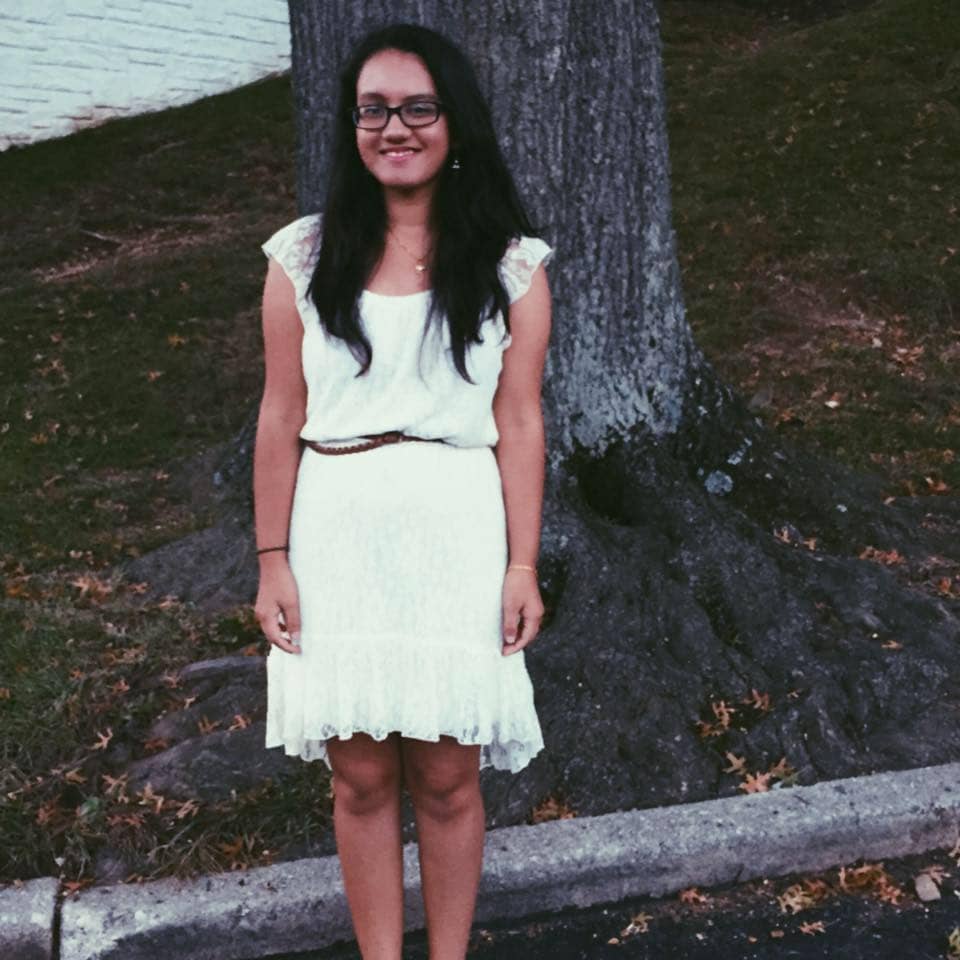
From the very first day of the internship, everyone welcomed me with open arms and made me feel like part of the team. Right off the bat, I was working alongside the team in the enrollment/registration process. It was exciting to see how spaces were filling up at the different sites as we inched closer to the start of the program. In the weeks of preparations, there were lots of team meetings, phone calls made, supplies sorted, and lesson plans printed. Once the program began, I provided support at the eleven different sites.
The most rewarding part of the internship was seeing the students engage in arts-integrated literacy workshops with teaching artists and visitors. Every time I stepped into a Weinberg library, students were participating in activities that showed creativity and innovation. I loved seeing collaboration amongst students when they were building 3D kinetic creatures with Futuremakers or when they were writing and performing hip hop verses with Bomani. I was able to capture many moments like this and post them on the SummerREADS Facebook page. Managing the Facebook page allowed me share photos of all the learning that took place, whether a site was learning about music, dance, theater, or visual arts on a particular day.

It makes me proud to have been part of a team of hard-working and dedicated people. I was constantly surrounded by people that were truly passionate about their job and who did everything they could to make the program a success. Everyone I met, from the librarians and teachers to the staff at YAMD, helped me grow not only at my job, but also as a person. Throughout the whole experience, I was able to see how a summer program that promotes arts in education really changes lives. It gives a child an opportunity to elevate their learning and dream big.
SummerREADS is a free literacy initiative that provides weekly drop-in programming for Baltimore City students. Each host school and library offers a safe and welcoming space where students can participate in literacy workshops with teaching artists and enrichment activities with special guests. Students also earn incentives for reading, receive two free and well-balanced meals per day, take books home, and access other library resources.
Voices for a Relevant Future: 2019 Bloomberg Arts Internship
This week, 35 Bloomberg Arts Interns—all rising seniors in Baltimore high schools—will be winding down their travels in and out and through our city’s marvelous historic and contemporary art-filled spaces. We are lucky, here in Baltimore, to have such esteemed institutions that not only teach, but listen. They value our young people’s contributions and know that in order to ensure a vibrant future, they must consider voice in their collections, among their staff, and at the helm.
Baltimore is not alone in its work to become more inclusive and reflective of the community among leadership and staff. “In a city that prides itself on both the diversity of its population and its globally recognized cultural institutions, there is a lopsided reality: While about two-thirds of New Yorkers are people of color, two-thirds of the people who run its cultural institutions are white,” wrote Julia Jacobs for the New York Times.

“Our interns are high school students. They are growing up in a world where equity is important and know what it truly means for a space to be equitable for all,” said Philip Muriel, Bloomberg Arts Internship Lead Coordinator. “Our worksite partners are providing extensive opportunities for our interns to help make their institution more aware and inclusive.”
Twenty local arts facilities and museums are currently providing positions within their institutions to our interns that offer a wide range of dance, music, art, theatre, cultural, and curatorial opportunities. In 2017, our first cohort of interns visited the Baltimore Museum of Art and learned about the museum’s challenge of not just welcoming the community, but making sure the community feels welcomed in the space. There is a difference.
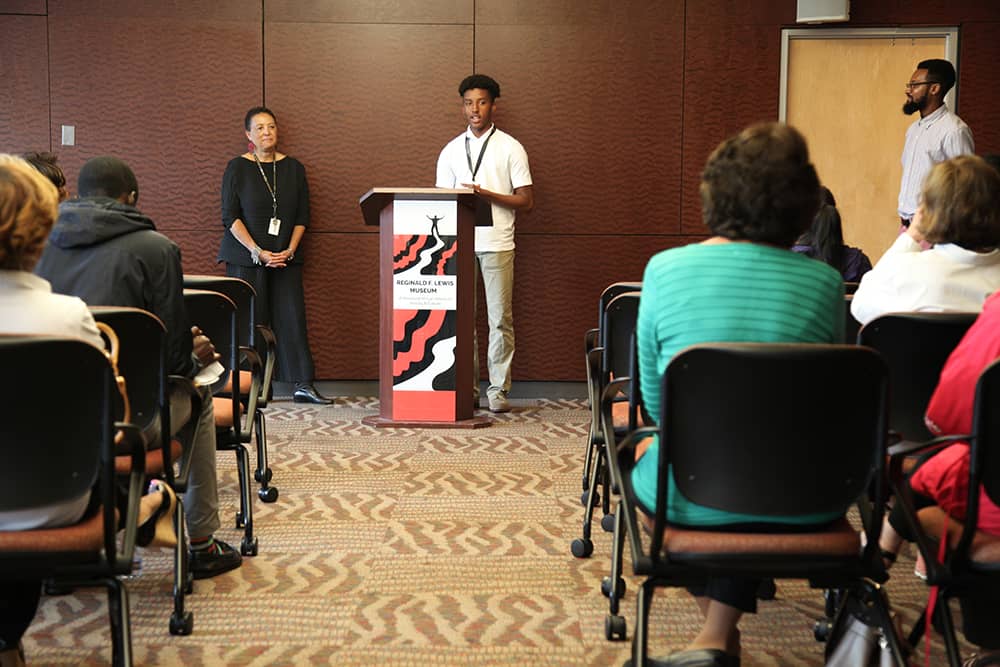
Less than a year later, acclaimed artist Amy Sherald joined their board. Christopher Bedford, the museum’s director, said in a statement, “As we develop a new strategic plan, it is important to have the voice of artists like Amy on the BMA’s Board of Trustees. Amy will bring a unique perspective to museum leadership, one that not only draws on her career as one of today’s most important artists, but also on her ties to the city of Baltimore itself.”
“Static, monolithic history must be supplanted with histories, plural—even as museums continue to safeguard the past in the objects they conserve and display. Directors and their staffs can enact bold forward-looking visions only when their boards support them in seeing museums as spaces to challenge, take creative risks and not simply conserve,” wrote Darren Walker in a New York Times op-ed earlier this summer.
Changing narratives to reflect our very diverse population—one that is youthful, justice-minded, and looking to connect with and build upon the treasures that fill our institutions—does not detract or devalue. On the contrary, relevance ensures community involvement and support. It ensures that a new generation will love and enjoy and support our city’s museums. Relevance shows an institution’s willingness to evolve. Relevance builds trust and confidence in communities’ willingness to grow and learn alongside institutions both now and in the future.
Step into 1 West Mount Vernon Place, the Walters Art Museum’s 19th-century mansion, and you are not just engulfed in the luxurious architectural details and pristinely preserved artifacts from distant cultures, you are drawn into stories. Works from ceramicist Roberto Lugo illuminate the life of Sibby Grant, as does the community art project, led by local ceramicist and educator Herb Massie and art program Jubilee Arts, which incorporates over 200 plates made by members of the Baltimore community.

Now wrapping up its third year in Baltimore, the Bloomberg Arts internship is ensuring that our students’ ideas and contributions are helping to shape and secure the future and relevance, as well as the inclusiveness, of arts organizations in Baltimore and beyond.
“Two of our interns, Connor and Isabelle, are working at the Walters Art Museum on a gallery guide aimed toward teenaged guests,” Philip said. “Another, Sonia, is interning at Wide Angle Youth Media where she is working as a journalist this summer investigating the dangers of heat-related illness in low-income communities.”
At all of our 2019 worksites, these students’ ideas are valued, their participation is appreciated, and their voices are heard. And while there is still plenty of hard work to do to achieve equity and representation within our arts and cultural institutions, we can at least know that these aren’t just places where community and student voices are welcomed, but places they are wanted.
The Bloomberg Arts Internship is managed by Young Audiences through the support of Bloomberg Philanthropies. It is a rigorous eight-week program providing 35 rising Baltimore high school seniors crucial college and career readiness preparation through hands-on, real-world workplace experiences and professional development. We are so proud of our interns and all they have accomplished this summer. Learn more about the program at yamd.org/bloomberg-arts-internship.
The Tangible Intangible: A Witness to the Power of the Arts
Written by Alan Hoff,
Young Audiences Board of Directors, Vice Chairman
The arts are not just nice, they’re critical to the development and well-being of our communities. I am both excited and proud that Baltimore County has continued to recognize the importance of funding for the Arts, particularly Arts in Education, in the current budget.
In addition to being a proud citizen of Baltimore County, I am also the Vice Chair of the board of Young Audiences/Arts for Learning, an arts-in-education organization that serves more than 12,000 Baltimore County students each year. I also serve as the president of the board of WTMD, Towson University’s radio station.
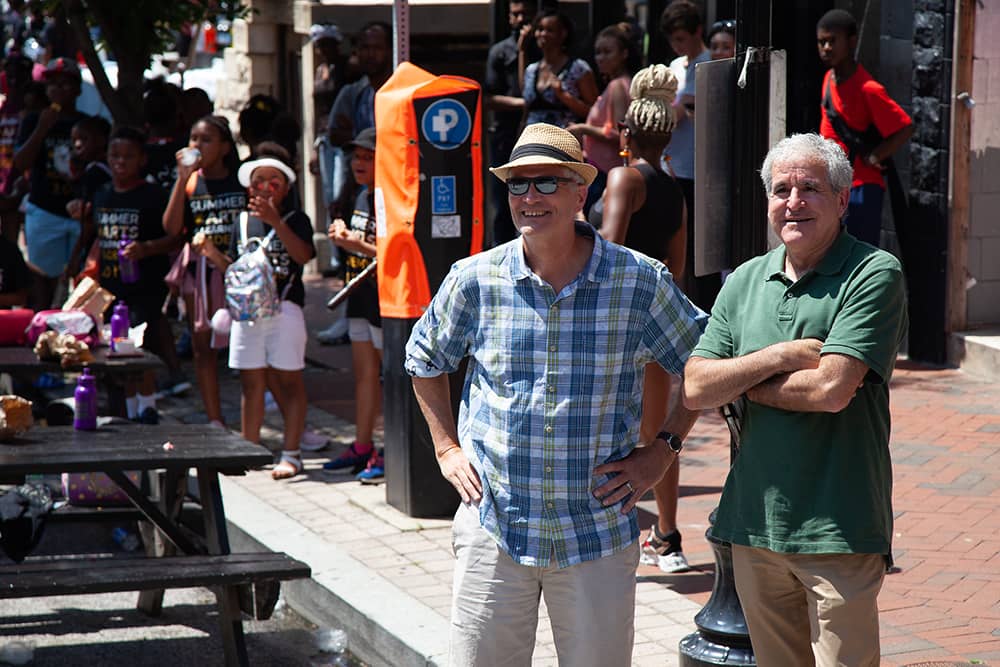
I’ve seen the power of the arts and what the arts can do for our community here in Baltimore County. The fact that the County–even with budget challenges–has continued to support the arts is impressive and commendable.
From a pure cost-benefit analysis, the arts provide a strong return on investment to the County. For example, Young Audiences is grateful to have received $40,000 in funding from the Citizens of Baltimore County through the Baltimore County Commission on Arts & Sciences last year. At the same time, with that investment, we served more than 12,000 County students and provided nearly $770,000 in payments to teachers and to teaching artists who live in Baltimore County.
Beyond a cost-benefit analysis is what I call the tangible intangible: The power of the arts that I see every day. I see it in kids’ eyes, I see it when they look up to a teacher who they admire, I see it in the difference it makes in helping them learn, and I see the impact the arts have in programs like WTMD’s Saturday Morning Tunes where we’ve literally welcomed thousands of kids and their parents.
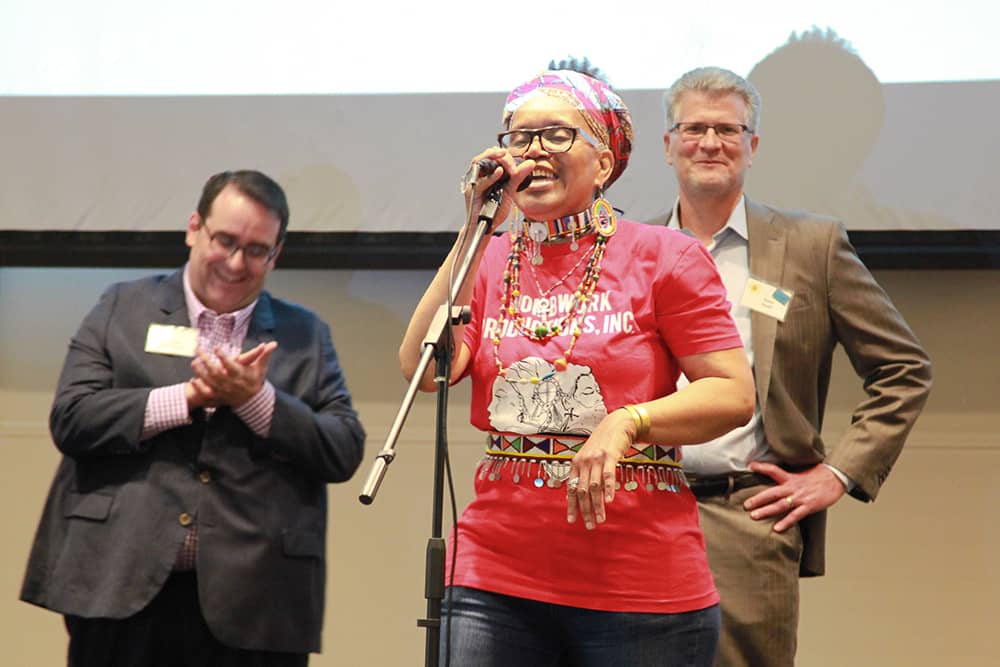
At Young Audiences, I have seen students learn fractions by beatboxing, math from drumming, and grammar from a poet or a spoken word artist. Not only do the arts provide kids with opportunities to express themselves and build confidence, but they also support all those educational priorities we talk about–like math and reading skills.
I’m probably the biggest anomaly that there is to talk about the power of the arts. I’m a lawyer–and I’m a business lawyer at that. But I am making this case because I see every day the power of the arts and I see that it makes a difference in people’s lives.
Alan Hoff joined Young Audiences, Arts for Learning Maryland’s Board of Directors in July of 2014. In addition to volunteering on both the Executive and Bridging the Inspiration Gap Committees, he currently serves as Vice Chairman of the Board. Alan has volunteered countless hours of his time and is a passionate advocate for ensuring the artistic, emotional, and intellectual growth of the children in our community. We are thankful every day for his advocacy, for his voice, for his vision, and for his generous spirit.
Art Inspires Math Inspires Art: The Ripple Effect of Arts Integration
What does learning look like in June? It’s hot, kids are getting restless, and classes don’t typically get any easier academically. Quite the opposite, in fact, for Algebra 1 students and teachers at North County High School in Anne Arundel County Public Schools (AACPS) who, in their final weeks of 9th grade, worked on teaching and understanding one of the class’ most difficult concepts: Graphing Piecewise Functions.
In the past, through the Arts Empowered Minds Initiative, the Math department at North County High has enlisted a slam poet, a storyteller, and a steel drum musician to help teach Algebra 1 concepts. This year, they invited YA roster artist Christina Delgado to guide the 9th-grade students and teachers through the art of photography to produce images that symbolize points on a Piecewise Graph.
Piecewise functions have multiple equations that define different sections of a graph. One section may look like a straight line, the adjoining section may look like a parabola. Rather than having one equation that defines the graph, there are multiple equations that define the function for specific sections.
To bring this concept to life, Christina and the mathematics team took the complex math idea and made it personal. Students were asked to tell the story of their freshman year of high school and translate that story to a graph with the X-axis representing time and the Y-axis, happiness. As with life itself, happiness over time does not always look like a straight line or a steady curve—sometimes there are sharp turns and big ups and downs in short periods of time. Students started with the story they wanted to tell—the story of their school year, then worked backward to graph these stories over time and layered them over a photograph of their creation and choosing.
 The students took the art form very seriously and paid close attention to Christina’s advice and direction—and because the teachers participated along beside them, they were able to experience the pleasure and resonance of learning through photography. They were able to relay this experience while leading a professional development course for the rest of the math department, giving them a small taste of how integrating the arts not only helps students grasp difficult concepts in math, but helps build community and understanding in the classroom.
The students took the art form very seriously and paid close attention to Christina’s advice and direction—and because the teachers participated along beside them, they were able to experience the pleasure and resonance of learning through photography. They were able to relay this experience while leading a professional development course for the rest of the math department, giving them a small taste of how integrating the arts not only helps students grasp difficult concepts in math, but helps build community and understanding in the classroom.
“It’s a great way to learn how your students learn,” Christina told the teachers. Mr. Kellermann and Ms. Russell recounted how much their students enjoyed working on the projects—projects that were meaningful to them. “I learned a lot about the kids I didn’t know—it was cool sitting and talking with them and talking about their stories.” In preplanning sessions, students wrote stories about their lives, highlighting events that had an impact on them. Teachers helped students identify symbols that could represent critical points in these stories.
The Algebra 1 teachers walked the rest of the math department faculty through the same initial exercises their students completed on the first day of the residency. Just like their students, the teachers learned to operate and care for their tools and to use them respectfully. After reviewing some of the children’s final projects, talking about the choices their students made, and what elements were included to make their photographs visually interesting, the teachers set off on a scavenger hunt of sorts. They were to collect three images on their digital cameras: One of a colorful circle, one of a triangle, and the last one, showing pattern.

When their students were first handed cameras, they immediately wanted to take pictures of themselves and their friends. They quickly shifted their focus to the environment around them, however. They became observant and attentive. Now faculty members were able to see that being behind the lens requires them to look around and take note of what they are seeing—to be purposeful of what they are capturing in the frame. “I was trying to take a picture of this flower,” one teacher commented, “but a person blocked the way. It was like we partnered on it. It was kind of cool.”
That kind of partnership is something Christina fosters in her classroom residencies. “Actually, one of our rules is to cooperate,” the artist told educators. You have to share equipment, so students have to remind each other of how to handle cameras safely and carefully, but they will also share ideas and photo-taking techniques like perspective.
The faculty returned to the classroom to share their images. Their excitement and level of anticipation while waiting for the photos to upload matched their young students. One teacher, upon seeing a colleague’s photo of a circle, exclaimed, “It looks like Saturn!” As they clicked through the images together, Ms. Russell reminded them that in the classroom, reviewing the work does not signal the end of the lesson. This, too, was an opportunity to engage. “Alright guys, this is a great picture. Now how can we make it better?”

Day One: Camera Basics and Color, Line, and Pattern
The classes learned to operate and care for their tools and to use them respectfully. They then learned to identify visual art elements through the lens of a digital camera. After reviewing examples of Christina’s own work, talking about the choices an artist makes in capturing images, and what makes a photograph visually interesting, students and teachers set off on a scavenger hunt of sorts. They were to collect three images: One of a colorful circle, one of a triangle, and the last one, showing pattern.
Days Two and Three: Composition, Symbolism, and a Final Image
Christina arrived with bags overflowing with curious objects, colorful mementos, magazines, and flags. Everyone was excited to sort through the treasures to find the perfect piece to symbolize a moment in their story. Their task on this day was to put that object into a specific environment and use their cameras to capture it from a point of view that would support its meaning. “People were really mindful about how they were holding their cameras and the colors they used,” said the artist about students’ final photos.
Day Four: Visual Stories—Graphed
Students and teachers plotted timelines using a piecewise graph, then transferred the graph directly onto their final images. From yet another bag of goodies, the class added multimedia collage elements—stickers, multicolored transparency film, pipe cleaners, yarn—the works! “I encouraged the students to try and be creative about how they wanted to draw their line or how they wanted to tell their story a little bit deeper—maybe add some words and some embellishments to make their pictures stand out a little bit more.” They were able to create some really interesting and compelling multimedia pieces. “You’re seeing the graph, but you’re also seeing the visual representation of the graph or the story.”

Looking to the Future
Is it any wonder that positive energy and the excitement of big ideas in teaching will ripple through a school community and spark even more minds and imaginations? The math teachers at North County High School (NCHS) brainstormed many additional concepts they’d like to teach through digital photography. And the art department was so excited to see the Algebra 1 students’ finished pieces that they plan to replicate this exact lesson for their art students.
As even further evidence of their commitment to arts integration, NCHS just received a $40,000 STEM + Arts Integration grant from the National Office of Young Audiences Arts for Learning to support a year-long arts integration program with their 9th-grade Algebra students and YAMD teaching artists. Christina Delgado will be traveling to Kansas City, MO this August with Lacey Sheppard, AACPS Arts Integration Teacher Specialist, and Hana Morford, YAMD Education Director of Statewide Initiatives, to take part in a Professional Learning Institute to develop the program’s curriculum. We cannot wait to see the lesson plans that will emerge.
Learn more about the Arts Empowered Minds Initiative, its collective impact partners, and the community it serves by visiting artsempoweredminds.org.
Imagine the Connections…
Written by Barbara Krebs,
Young Audiences volunteer and Sunburst Society member
“What does the artist do? He draws connections. He ties the invisible threads between things.”
—Anselm Kiefer, German painter and sculptor
A few weeks ago, Young Audiences hosted an event to celebrate the organization’s supporters and the arts and education experiences that, together, we were able to bring to Maryland students over the past year.
I imagine the connections. From teacher to student. From student to parent. From tap dancing to the nucleus of an atom. From all the “invisible threads between things.” That’s what Young Audiences does: Connects kids and imagination to education through the arts.
Having been to a number of YA’s events, I had a reasonable idea of what to expect. Inspiring statistics of successes achieved in area schools. Teaching artists demonstrating classroom arts techniques. Audience participation. Delicious hors d’oeuvres and delightful cocktails. Animated conversations that explore the arts and our connection to Young Audiences. And on this occasion, expansive views of Baltimore’s Inner Harbor.
It’s easy enough to write this basic list of how YA celebrates. What’s harder to capture is the excitement, inspiration, imagination, and connectedness that ensues.
For example, teaching demonstrations began with Khaleshia Thorpe-Price, who is involved with a program new to Young Audiences: Baby Artsplay. This program provides engaging activities designed for parents, caregivers, and early childhood educators to use the arts at home, daycare, and school to set our youngest learners on a path toward kindergarten readiness.
As she passed out small egg-shaped rattles (easy for small hands to hold), she explained how she uses simple songs and movement to engage the kids. Later she distributed scarves, which were used in a peek-a-boo song that encouraged creativity, imagination, and movement.
See, describing it doesn’t do it justice – but if you can just visualize for a moment (encouraging active imaginations here!) a roomful of slightly self-conscious professional people waving scarves up, down, and sideways while they “flew” or “sashayed” or “danced,” you begin to get an idea of how this reaches young kids who have no inhibitions about imaginative play. And better yet, these are techniques that can then be taken home and easily recreated to help children learn through play.

How about tap dancing? Quynn Johnson made music with her feet! Sliding, spinning, tapping toes, tapping heels–the rousing rhythms got and held our attention just as it does the K-8th-grade students she instructs. Whether it’s math, science, or literacy, her feet teach the lesson. I asked her about that later, admitting that I understood how tap dancing could teach math. But I wondered how she connected this art form to science and English. I then learned how she taught different rhythms to illustrate the nucleus of an atom; or the life cycle of a hurricane; or the development of Pinnochio from a wooden puppet, to a wooden puppet with a long nose, to a little boy.

Last up was Regie Cabico, a slam poet and theatre artist who produces wonderful, thought-provoking performance art informed by his Filipino American identity. Working in theatre, he constantly struggled to secure roles, being labeled “not Asian enough” for some and “too Asian” for others. And so he connects with his students, who also grapple with not being or appearing “something” enough. Feeling “other” is a universal theme that connects us all.
So I imagine the connections. From teacher to student. From student to parent. From tap dancing to the nucleus of an atom. From all the “invisible threads between things.” That’s what Young Audiences does–connects kids and imagination to education through the arts.
Belonging
Written by Stacie Sanders Evans,
President and CEO of Young Audiences/Arts for Learning
Belonging. That’s the word that has been on my mind. Our founder, Nina Collier, understood belonging. She felt music belonged in schools, that artists belonged in a child’s education. In 1950 she inspired a movement of artists-in-schools. What started in Baltimore has now grown to 30 Young Audiences–the largest arts-in-education network in the US.
Today, Young Audiences artists like Femi the DriFish and Valerie Branch ignite a child’s desire to learn. Whatever our partner artists’ art form is–hip hop dance or improvisational theatre–they use it to draw kids into learning. We train our artists to integrate their art form with whatever is being taught in students’ literacy, math, social studies, and science classes.
We do that because when kids create something they get to make choices. They make meaningful connections. They express themselves. Choice and voice–that makes the learning matter.
When we, as a community, provide children with these kinds of opportunities, we are telling them, “You matter!” All of this, what we do, it nurtures the sense of belonging in our kids, artists, parents, and teachers. And it is belonging that I feel when I walk into one of our classrooms. Listen to how Tiffani, Dawn, and Valerie talk about our community in Together–we are their people–and we all belong.
Think back to when you were growing up. Who were YOUR people? What teacher or coach left their imprint. Who helped you become the person that you are today? I bet that person made you feel visible. Known. That you belonged.
My moment was in ninth grade. I was struggling in many different ways and my drama teacher, Mrs. Howard, saw something in me. She knew how to draw that “something” out–just like the 200 artists (both YA roster artists and independent artists) we work with. In her class, I belonged. She cast me as Juliet in Romeo and Juliet. And that moment was like rocket fuel for me.
Belonging is a strong human need, particularly in our children. I see belonging as the net below the trapeze. When kids have that net of belonging, they are more likely to lean into learning–kids like Josh Ajala, who in Together, spoke about moving from the back of the class to the front–and his sister Tiffani Ajala–who was brave enough to apply for Baltimore Design School (and got the highest possible score on her fashion portfolio!) These are the courageous risks we want our kids to take so that they can grow.
But public education for the last 17 years, after the birth of No Child Left Behind, hasn’t been focused on this. It has been about raising standards and increasing school accountability–measured through standardized testing. What do kids who are part of this system think about this? In Brenna’s poem, she says students feel like they are just inputs and outputs in one simple equation.

The outcomes we are seeing are heartbreaking and not sustainable as a society. Eight out of ten Baltimore City Schools students do not meet “proficiency” in math or reading. Nearly half of our children across the state entering Kindergarten are already behind. Four out of ten Maryland teachers leave teaching within five years because this isn’t the equation they want to be a part of.
A different way is needed. Young Audiences is a different way. Our movement is to make sure all kids–and the people who teach them–are not treated like inputs and outputs but as the whole beautiful human beings that they are.
Today, thanks to our 450 school partners, our Sunburst Society members, and our game-changing evidence, our movement is growing. Outreach has doubled in the last five years. We impact the education of 191,000 children EVERY year–children in EVERY Maryland county.
We are on a mission to close the opportunity gaps in this educational system. We have four strategies:
- Preventing summer learning loss by operating 20 summer programs across our city
- Increasing school readiness through early childhood programs in four counties
- Improving student engagement in learning by providing professional development to 500 teachers every year
- Increasing equity in access to opportunity–more than 30,000 of our children are in under-resourced communities, so we provide more to them
We have made tremendous progress over the last five years but we can take this to a new level. Five years from today, I think we can change the educational trajectory of 50,000 more kids. Here is how we can get there:
- Expand our evidence-based Summer Arts & Learning Academy in and beyond Baltimore City. This is the program that Tiffani, Alice, and Josh participated in that continues to have a ripple effect in their life. To expand to just one more school district, we have to find and train 20 more artists.
- This Academy is only 25 days of a kid’s life–and in that short time, we see lots of benefits. Imagine if kids had that kind of arts-integrated learning during the school year and school day? We want to launch year-round professional development and support for teachers and principals to make that happen. If we were able to add just one more person to our staff that focused on professional development, we could support 100 more teachers and principals every year.
- To have the greatest impact on a child’s potential, we need to invest early. (Did you know that 80% of the brain’s synaptic connections are made by age 3?) In 2024, we want to bring our Baby Artsplay program to 5,000 infants and toddlers across Maryland and–to their very first teacher–their parents. This will require our artists to be trained in early childhood development.
Think back to your person–your Mrs. Howard. Think back to that feeling of belonging. Imagine if you could create that opportunity for someone else. For another Josh. Another Brenna. Take that opportunity and multiply it by 50,000. Fifty thousand children sitting in the front of the class, trying out for Baltimore Design School, reaching for that trapeze handle.
That is the opportunity in front of us. For Brenna, that is the equation she wants us to come together and solve.
Internships – A Crucial Stepping Stone for Success
Written by Barbara Krebs,
Young Audiences volunteer and Sunburst Society member
Classes may be just about to wrap up, but for 33 Baltimore students who have accepted positions in the Bloomberg Arts Internship this summer, a different kind of learning experience is only beginning. Young Audiences, with funding from Bloomberg Philanthropies, established a now eight-week program three years ago to offer paid internships to rising high school seniors. Twenty local arts facilities and museums are currently providing jobs that offer a wide range of dance, music, art, theatre, cultural, and curatorial opportunities.
It’s no great secret that internships are often viewed (and rightfully so) as stepping stones to higher education opportunities and greater career possibilities. Internships offer high school and college students crucial job skills and mentorship relationships that help them stand out in an often crowded job market. But paid internships can be few and far between.
The Bloomberg Arts Internship aims to make paid internships in the arts and culture field more inclusive and available to students who otherwise may not have the opportunity to network and build skills in that professional setting.

An article–How Internships Are Changing the Art World–from Artsy.net has this to say about how intertwined the relationships and skill building are. “It’s not only that your intern could be your successor, they might one day be your colleague,” said Selene Preciado, program assistant for the Getty Marrow Undergraduate Internships in Los Angeles.
Indeed, they might! But these Bloomberg Arts internships go far beyond job training and networking, as important as these are. These students will gain familiarity and comfort with workplace etiquette, improve verbal and written communication skills, explore cultural assets in our city, develop critical life and work skills, and prepare to apply and transition into college. In addition, the program aims to encourage a more equitable and diverse range of staff and audiences among cultural institutions, while instilling in the students an understanding and appreciation of the important civic contributions of arts and culture.
That’s a lot to learn in just eight weeks! And yet, these arts internships provide not just amazing arts education, the students also strengthen their:
- computer capabilities (Center Stage – “how to use leading software for the industry”)
- research, interview, and publishing skills (Baltimore Office of Promotion & the Arts – “the student will research history, interview artists, and ultimately publish a youth-organized ‘tour’ of murals and sculptures”)
- proficiencies in following a project to completion (Maryland Film Festival – by curating and promoting short films, the student will “be involved in every aspect, from curation to marketing to execution.”)

In short, skills to last a lifetime. In the Artsy article, Maxwell Anderson, president of the Souls Grown Deep Foundation in Atlanta said, “Museums desperately need talent in all sorts of positions–curators represent a fraction of the staff of museums. We’d be thrilled if an accountant emerges from [our program] and finds their way into the museum profession, but they’re an accountant who has knowledge and experience in a particular cultural remit that otherwise they may not have.”
In the short bios that the students provided, I noticed one recurring theme: learning. These are students who have a passion for learning, who will make the most of their internship, and who will carry what they learn with them into the future. I have no doubt that they will take this small stepping stone and use it to build a solid foundation in the years to come.
Preparing for Improvisation
Written by Barbara Krebs,
Young Audiences volunteer and Sunburst Society member
The thing I like most about Young Audiences’ Impact Breakfast is that I never know what new insight I will take away from it. Sometimes I go home and think about the things I heard and saw, and something takes root and grows from my pondering. Other years it hits me immediately with, um, impact. This year’s Impact Breakfast was of the second variety.
It started with the music. Because the day began with rain, award-winning Folk singer and guitarist Letitia VanSant welcomed guests with her songs in the lobby of the Vollmer Center, and not outside, like planned. She played and sang softly, setting a mood of serenity. Ahh, yes, very pleasant as I sipped my coffee. And then as I started looking at Maura Dwyer‘s handmade crankie, a wooden box containing an illustrated scroll that reveals a moving picture story as it is slowly wound by the artist, a very different style of music was unleashed–ragtime! Now that gets the blood pumping!
The guitarist’s intimate melodies were quickly drowned out. Assessing the situation–and the weather, YA staff and board members moved the duo’s entire set-up where they belonged all along–just outside, at the entrance of the building. And that improvisation really worked, as Letitia’s musical style and the moving panorama that accompanied her songs connected naturally to the park-like setting surrounding the Vollmer Center. You can’t control the weather, but you can spring into action when it changes for the better!

After listening to her a while, I wandered back into the building to take in some more ragtime and to look over the student works displayed downstairs. And that’s when one of the accompanying quotes struck me. Labeled “What Students Have to Say,” a 6th-grade improvisational theatre major stated, “My favorite major is improv because of how we can laugh and be silly. We can be anything because it is based on your imagination. In your imagination you can be anything and see anything.” Exactly!

More improvisation followed as Mama Rashida and WombWork Productions performed. With Virtues as the theme and a backdrop listing a huge variety of positive qualities, she prompted the audience to participate in a call-and-response activity, shouting out “gratitude” and “unity” and “creativity” as we swayed in our seats and responded, “yeah, yeah!”
When it was time to hear Femi “The Drifish” Lawal speak, I have to admit I was particularly happy to hear from him. That’s because I have been fortunate enough to have had the opportunity to observe him in action in the classroom, at Art Crawl and at introductory “house” parties that showcase what YA does. In all of these settings, he’s a master at getting both kids and adults involved.

So I was both surprised and amused to hear him admit to “winging it” before he began working with Young Audiences. But what did not surprise me was to learn how his involvement with Young Audiences helped him hone and master his teaching style. He knew he was already positively impacting young lives in the classroom, but with YA’s assistance, he learned techniques that extended what he could offer and bring out in the kids.
As a person who enjoys contradictions, I thought about the nature of improvisation. Yes, it is about doing things without previous preparation. Yes, it is about responding to whatever circumstance comes your way. And yes, it is about reacting to your imagination as the 6th grader said.

But… it is also about the preparation, oddly enough. When you prepare fertile ground for your imagination to take you places, you become increasingly comfortable with the journey, and you find new and creative ways to respond to real-world situations. When you learn classroom techniques that allow children to explore their worlds in different ways, you discover the power of improv paired with preparation. How it helps them rap their way to mathematical formulas, dance their way to literature themes and draw their way to social justice.
So at this year’s Impact Breakfast, I learned that preparing for improvisation is not quite the oxymoron it appears to be. Because no matter how prepared you are, you need to be able to improvise when the moment calls for it. And no matter how stellar you are at winging it, preparation makes it easier to soar on those improv wings.
Visit our Flickr page to see more images from Young Audiences’ annual Impact Breakfast.











